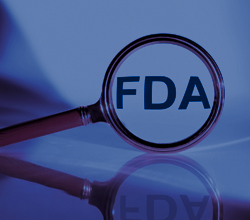
Validation of Rapid Microbiological Methods
 Scott Sutton
Scott Sutton
 90 Min
90 Min
Product Id: 701240
This biotech training will look at different methods to validate the alternate method and Validating of Rapid Microbiological Methods.

Meeting FDA Requirements for Over-the-Counter / OTC Drug Labeling
 Alfredo J Quattrone
Alfredo J Quattrone
 60 Min
60 Min
Product Id: 701229
This FDA compliance training will provide valuable assistance to all new & existing OTC drug firms that are regulated by FDA due to their domestic USA sales.

Qualification and Audit of Suppliers and Vendors - A Risk Based Approach
 Michelle Sceppa
Michelle Sceppa
 60 Min
60 Min
Product Id: 701189
This Pharmaceutical compliance training will demonstrate how to implement an effective audit program for both manufacturing and the laboratory and the ability to maintain GMP/GLP/GCP compliance with all suppliers and/or vendors.

Bringing Compliance to Design Control through Life Cycle Management of Older Medical Devices and Surgical Instruments
 Rob Braido
Rob Braido
 60 Min
60 Min
Product Id: 701230
This Life cycle management training will provide valuable assistance and gives a process to product design history files and technical files up to date with the new standards through life cycle management.

Evaluating the Effectiveness of your ERM Program: Linking shareholder value with superior governance and ERM
 David R Koenig,Dr. Robert Mark
David R Koenig,Dr. Robert Mark
 60 Min
60 Min
Product Id: 701231
This Enterprise Risk Management training (ERM) will provide a framework for evaluating the effectiveness of risk management based on an inventory of questions an effective ERM program should be able to answer.

Aerospace -Transitioning to AS9100 Rev.C
 Rick Saldivar
Rick Saldivar
 60 Min
60 Min
Product Id: 701166
This AS9100 compliance training will provide an understanding of the changes and requirements AS 9100 certified organizations will need to address to be compliant to the new AS9100 Revision C Standard.

Delivering Biopharmaceutical Facilities in a Risk Based World: The Role of GEP, QbD, and E2500
 Jeff Odum
Jeff Odum
 60 Min
60 Min
Product Id: 701207
This Biopharmaceutical training will introduce and link the concepts of GEP and QbD and also identify synergies with the new ASTM E2500 standard Biopharmaceutical Active Pharmaceutical Ingredients (APIs) must be produced according to Good Manufacturing Practices outlined in FDA and ICH guidelines in order to be marketed to the public. This webinar will review the areas that an inspector may examine when conducting an audit of a biopharmaceutical API supplier to ensure it complies with regulatory requirements.

Software Verification and Validation For FDA-Regulated Industries
 John E Lincoln
John E Lincoln
 60 Min
60 Min
Product Id: 701135
This FDA compliance training will guide you through Software Verification and Validation process in FDA-Regulated Industries. U.S. FDA Warning Letters and recent high-profile recalls indicate major cGMP deficiencies in many companies. One major failing is lack of sufficient or targeted risk-based software V&V. Starting with a Project Validation Plan, evaluating its elements against ISO 14971:2007 hazard analysis / risk management, allows development of meaningful product / process validations. The roles of different V&V protocols. How to employ equipment / process DQs, IQs, OQs, and PQs, against a background of limited company resources (personnel, budget, time). Two matrices / models simplify regulatory requirements for “as-product”, “in-product”, process, and equipment, et al, software V&VT, assuring key FDA requirements are not overlooked. QMS and 21 CFR Part 11 require yet another approach.

Combination products and convergence: an overview of clinical benefits, regulatory issues and manufacturing challenges - part 1
 Michael Drues
Michael Drues
 90 Min
90 Min
Product Id: 701158
This Medical device training will guide you through Combination products and overview of clinical benefits, regulatory issues and manufacturing challenges. Medical products, no matter how well designed, can only do so much to address many of the clinical problems today. In order to tackle the clinical problems of the future, medical devices will be used in combination with drugs and biologics (called combination products) to treat a wide range of diseases from heart attack and stroke to Alzheimer’s and diabetes and beyond!

Risk Evaluation and Mitigation Strategies (REMS) what you need to know in order to comply with FDA's new requirements
 R. Wayne Frost
R. Wayne Frost
 60 Min
60 Min
Product Id: 701155
This FDA compliance training will be valuable who are involved in the development of REMS and who are planning a submission and need to understand what might be required by FDA and how to comply and for those who have Risk Management Plans.

Cleaning & Cleaning Validation; an Overview
 Gamal Amer
Gamal Amer
 60 Min
60 Min
Product Id: 701149
In this Cleaning validation training we will discuss preparing the cleaning validation protocol. Important aspects such as how to set acceptance criteria and how to measure cleanliness will then be reviewed.

Rules of Practice (FSIS) 9CFR part 500
 John Miller
John Miller

Product Id: 701172
This Food Safety and Inspection Service (FSIS) training will guide you through the different levels of enforcement that FSIS utilizes.

The Reimbursement Process
 Jeff Kasoff
Jeff Kasoff
 60 Min
60 Min
Product Id: 701144
This Medical device training will discuss how to design and implement a comprehensive, streamlined reimbursement strategy. Many companies do not have an individual responsible for reimbursement. This is a huge mistake! Medical device reimbursement is the second largest barrier to market entrance. FDA approval/clearance is NOT sufficient to ensure reimbursement. Strategy must be devised early in a product’s lifecycle to maximize reimbursement. Learn how to design and implement a comprehensive, streamlined reimbursement strategy. Learn the basics of coding, coverage and payment activities.

21 CFR Part 11 compliance under the Obama administration
 Alfonso Fuller
Alfonso Fuller
 60 Min
60 Min
Product Id: 701215
This 21 CFR Part 11 training will deliver concrete guidance which will provide a roadmap for compliance that will have immediate benefits, withstand FDA’s changes to Part 11, and discuss the new Obama administration approach to enforcement.

Critical Control Points (CCP’s). Where are they? Why? When?
 Irwin Pronk
Irwin Pronk
 60 Min
60 Min
Product Id: 701180
This Food safety compliance training will explain the CCP Decision Tree and help you understand the principles behind each question. We will review various food processing steps in a variety of situations to determine whether they are CCP’s. What is the thought process in determining a CCP? Can it be done consistently? What criteria are used? Are some processing steps always CCP's e.g. heating? If not, why? One thing to remember is the importance of analyzing the hazards at each step very carefully. The more clearly the hazards are described (including equipment failures, personnel errors etc) the easier it will be to find the CCP.

cGMP 'Pitfalls' in the QC Laboratory-Preparing the QC Laboratory and Staff for an FDA Inspection
 Michelle Sceppa
Michelle Sceppa
 60 Min
60 Min
Product Id: 701187
The FDA Audit inspection training defines the laboratory environment; points out problem areas and common pitfalls; and details solutions and also details how to prepare the Laboratory staff for an Inspection as well.

Validation Planning to Meet US FDA and ISO 13485 Requirements
 John E Lincoln
John E Lincoln
 60 Min
60 Min
Product Id: 701206
This FDA validation training will guide you through the validation planning which required meeting the US FDA & ISO 13485 Requirements. FDA Warning Letters and recent high-profile recalls indicate major cGMP deficiencies in many companies. One major failing is lack of sufficient or targeted risk-based V&V planning. Starting with a Master Validation Plan, evaluating its elements against ISO 14971 hazard analysis / risk management, allows development of meaningful product validations. Also: The roles of different V&V protocols; How to employ equipment / process DQs, IQs, OQs, and PQs, against a background of limited company resources (personnel, budgets, time). A matrix simplifies “as-product”, “in-product”, process, and equipment, et al, software V&VT, assuring key FDA requirements are not overlooked. The QMS and 21 CFR Part 11 are considered.

Corrective And Preventive Action: CAPA-A Risk Mitigating Quality System
 Gamal Amer
Gamal Amer
 60 Min
60 Min
Product Id: 701146
This CAPA training will focus on defining the specific steps to be taken when implementing a CAPA system and review some of the possible pitfalls one may encounter when implementing a CAPA system. This presentation will begin by defining risk in compliance and the methods, which can be used to mitigate risk. One of the methods defined by the regulators and the industry is “Corrective Action Preventive Action” otherwise referred to CAPA. We will first define what we mean by risk. We will then explore the factors associated with risk in compliance. We will also explore risk causing events and how to address them. A review of risk severity/level will then ensue. Upon completion of risk part of the presentation we will define what a CAPA system would look like.
The presentation will focus on CAPA as it applies to risk mitigation. We will define what we mean by a CAPA system. We will further define the tools CAPA uses during implementation. Finally an overview of a CAPA system will be presented and a CAPA approach will be proposed. The approach will focus on defining the specific steps to be taken when implementing a CAPA system and review some of the possible pitfalls one may encounter when implementing a CAPA system. We will also review some of the benefits which may accrue by having a robust CAPA system in place.

Surprise FDA GMP inspection - how to prepare for it
 Peter Calcott
Peter Calcott
 90 Min
90 Min
Product Id: 701203
This FDA GMP (Good Manufacturing Practice) inspection training will walk you through the elements you should plan for, the timing and the logistics of who should do the various components in preparation for the inspection.

Using ICH Q9 and Recent FDA Comments as the Foundation for the Planning, Development and Execution of Risk-Based Cleaning Validation Studies
 John Hyde
John Hyde
 90 Min
90 Min
Product Id: 701184
This Cleaning validation training will provide valuable assistance to all regulated companies that need to develop and validate their equipment cleaning processes. This session will address risk-based approaches to cleaning validation studies using ICH Q9 and recent FDA comments and observations as a foundation. Recent FDA warning letters illustrate just how critical good cleaning practices are. Understanding and employing good cleaning practices are instrumental to improving cleaning consistency, quality and traceability. The FDA favors automated CIP systems since they reduce operator variability while enhancing consistency and reproducibility. Our research has indicated that in the last 5 years, cleaning citations were noted in 50% of warning FDA letters. Many cited contamination issues have an element of poor cleaning practices associated with them. Examples include “investigations…did not include an evaluation of the cleaning processes and procedures…to determine if equipment cleaning is effective in preventing cross contamination of the inactivated batches”, FDA Warning Letter, Jan 2008; "vaccine manufacturing plant in Pennsylvania, has been served with an FDA warning letter asking for measures to ensure batches of its flu shot ingredients do not become contaminated again.” Jul-2006..
An overview of ICH risk management techniques and how to apply them to equipment cleaning programs will be discussed. In addition, case studies from manufacturing facilities will be used to illustrate risk-based cleaning validation principles and practices.


























